lingvo.wikisort.org - Language
Surjapuri is an Eastern Indo-Aryan language spoken in Eastern India including North Bengal, West Bengal, and Eastern Bihar, as well as in Nepal. Among speakers in some regions, it is known as 'Deshi Bhasa'. It possesses similarities with Kamatapuri, Assamese, Bengali, and Maithili.
| Surjapuri | |
|---|---|
| Sura, Deshi Bhasa | |
| सुरजापुरी, সুরজাপুরী | |
 'Surjapuri' in Devanagari & Bengali scripts | |
| Native to | India, Nepal, Bangladesh |
| Region | Bihar, West Bengal |
Native speakers | 2,256,228 (2011 census)[1] Census results conflate some speakers with Hindi.[2] |
Language family | Indo-European
|
Writing system | Devanagari, Bengali |
| Language codes | |
| ISO 639-3 | sjp |
| Glottolog | surj1235 |
Geographical distribution
Surjapuri is mainly spoken in the parts of Purnia division (Kishanganj, Katihar, Purnia, and Araria districts) of Bihar.[3] It is also spoken in West Bengal (Uttar Dinajpur and Dakshin Dinajpur districts, and in North Malda of Malda district, specially in Harishchandrapur and Chanchal area and Siliguri city of Darjeeling district – part of the North Bengal region within the Jalpaiguri division), Bangladesh (Thakurgaon District) as well as in parts of eastern Nepal.
Related languages
Surjapuri is associated with the Kamtapuri language (and its dialects Rangpuri and Koch Rajbangshi) spoken in North Bengal and Western Assam,[4] as well as with Assamese, Bengali, and Maithili.
Pronouns[5][6][7]
| Singular | Plural | ||||
|---|---|---|---|---|---|
| nominative | oblique | nominative | oblique | ||
| 1st person | mũi | mo- | hāmrā | hāmsā-, hāmcā- | |
| 2nd person | tũi | to- | tumrā, tomrā | tumsā-, tomsā- | |
| 3rd person | proximal | yāhāy | yahā- | emrā, erā | ismā-, isā- |
| distal | wahā̃y | wahā- | amrā, worā | usmā-, usā- | |
Surjapuri has the oblique plural suffixes: sā (hamsā-, tomsā-) and smā (ismā-, usmā-). They are also seen in Early Assamese as: sā (āmāsā-, tomāsā-) and sambā (esambā-, tesambā-) and their occurrences are similar.[8]
Phonology
Consonants
| Labial | Dental/ Alveolar |
Retroflex | Post-alv./ Palatal |
Velar | Glottal | ||
|---|---|---|---|---|---|---|---|
| Nasal | m | n | ŋ | ||||
| Stop/ Affricate |
voiceless | p | t | ʈ | tʃ | k | |
| aspirated | pʰ | tʰ | ʈʰ | tʃʰ | kʰ | ||
| voiced | b | d | ɖ | dʒ | ɡ | ||
| breathy | bʱ | dʱ | ɖʱ | dʒʱ | ɡʱ | ||
| Fricative | s | h | |||||
| Tap | ɾ | ||||||
| Lateral | l | ||||||
| Approximant | w | j | |||||
Vowels
| Front | Central | Back | |
|---|---|---|---|
| High | i | u | |
| Mid | e | ə | o |
| ɔ | |||
| Low | æ | ɑ | |
- Nasalization is also phonemic.
- /i, e/ in medial and initial form are heard as [ɪ, ɛ].[9]
Notes
- "Statement 1: Abstract of speakers' strength of languages and mother tongues - 2011". www.censusindia.gov.in. Office of the Registrar General & Census Commissioner, India. Retrieved 2018-07-07.
- "Statement 1: Abstract of speakers' strength of languages and mother tongues – 2001". Office of the Registrar General & Census Commissioner, India. Retrieved 30 May 2017.
- Kumāra, Braja Bihārī (1998). Small States Syndrome in India. p. 146. ISBN 9788170226918. Retrieved 16 February 2017.
- Hernández-Campoy, Juan Manuel; Conde-Silvestre, Juan Camilo, eds. (15 February 2012). The Handbook of Historical Sociolinguistics. John Wiley & Sons. ISBN 9781118257265. Retrieved 5 March 2018.
- (Toulmin 2006, p. 184)
- (Bez 2012)
- Kakati 1941
- (Bez 2012)
- Srivastava & Perumalsamy 2021.
References
- Bez, Gitanjali (2012). Grammatical Categories in Madhav Kandali's Ramayana (Ph.D.). Gauhati University. hdl:10603/116370.
Further reading
- Srivastava, S.P. and Perumalsamy, P (2021). Linguistic Description of Surjapuri Mother Tongue Spoken in Bihar, New Delhi: Office of the Registrar General.
External links
- Free repository of illustrated children's stories in Surjapuri translated by Azad India Foundation and sponsored by Pratham Books
- "Word Formation in Surjapuri" (PDF). Language in India.
- "Case and Case-like Postposition in Surjapuri" (PDF). Language in India.
- Toulmin, Mathew W. S. (2006). Reconstructing linguistic history in a dialect continuum: The Kamta, Rajbanshi, and Northern Deshi Bangla subgroup of Indo-Aryan (Ph.D. thesis). The Australian National University. hdl:1885/45743.
- A Sketch Grammar (2021) of Surjapuri mother tongue spoken in Bihar state
Другой контент может иметь иную лицензию. Перед использованием материалов сайта WikiSort.org внимательно изучите правила лицензирования конкретных элементов наполнения сайта.
WikiSort.org - проект по пересортировке и дополнению контента Википедии